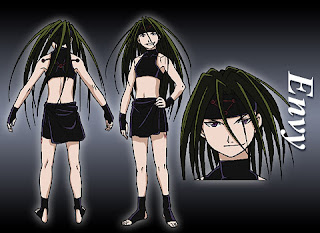Background: Dante's Inferno
Written records of the concept of the Seven Deadly Sins have been floating around as early as the 4th century. Though the list has gone the some revisions over the years; however, the commonly accepted list nowadays goes: Lust, Gluttony, Greed, Sloth, Wrath, Envy, Pride.
The Deadly Sins as a pop culture icons have their roots in the breakout religious-fiction text of 14th century Italy, Dante Aligheiri's
Divine Comedy. Throughout the
Comedy's three books Dante takes a journey through the three spiritual realms, Inferno, Purgatorio, and Paradiso (that's Hell, Purgatory, and Heaven/Paradise for you non-Italian readers).
Inferno was then, and is now, the standout text of the three. After all, it's got all the good, juicy bits, right? Rumor has it that after Dante had finished and distributed
Inferno, he overheard a woman whispering to her companion as he passed through town one day. "There goes the man who has toured the Abyss and yet still walks this earth," she said (or so the story goes).
Inferno had such a huge impact on Italian society that some thought its text be an entirely factual manifesto.
 |
| Modern Popularity Comparison: Forks, Washington residents don't actually believe in vampires. |
|
Inferno's depiction of Hell consists of a series of nine circles. Within each circle reside souls that were condemned for a particular sin; as Dante descends into the deeper circles of Hell, the sins being punished become more and more severe, while the circles become smaller and smaller. For all intents and purposes, Hell is pretty much an infernal bathroom drain. All the worst clogs congeal at the bottom.
 |
| Someone get us some Divine Drano. |
As you may have guessed, within these nine circles all seven of the Deadly Sins are represented, each with a unique punishment befitting their crime. Here they are, in order of Dante's descent into Hell.
In
Purgatorio, the souls of the Saved who go through the process of Purgation work their way up seven terraces in their journey toward Heaven, each representing one of the Deadly Sins (in reverse order of how they are listed here).
Lust
 |
| Francesca and Paulo, tragic adulterers condemned to the Second Circle. |
The Lustful are the first of the Deadlys that Dante encounters. Thus, this sin is seen by Dante to be the least severe of the seven. The carnal souls are punished by being eternally blown around by a tempestuous storm, a metaphor for the raging passions that controlled their earthly lives.
In
Purgatorio, those purging earthly lusts run through scalding flames while shouting out their sins.
Gluttony
Immediately after escaping the stormy Second Circle, Dante happens upon the Gluttons. These souls of wanton excess are forced to wallow in stinking mud and a ceaseless rainstorm, struck sightless and unaware of those around them for their selfish former lives.
In
Purgatorio, those ridding themselves of gluttonous tendencies are emaciated and starving, tempted by trees with fruit that is always just out of reach.
Greed
In the Fourth Circle, Dante finds the Greedy to be split into two groups: The hoarders, who kept all that they could with no regard for others, and the prodigals, who squandered recklessly what wealth they had. The two groups perpetually roll great stones with chests toward the stones of the other group, clashing together violently, unable to comprehend the other group's mentality in the least.
In
Purgatorio, being cleansed of greed involves lying face-down, completely paralyzed, while reciting prayers against their covetousness.
Sloth & Wrath
The Fifth Circle contains the river Styx. Below the river Styx's surface, constant streams of bubbles rising to the surface are the only indicator of the presence of the Slothful, submerged for all eternity into the riverbed. Their laziness in life gives them no pleasure in Hell, trapped as they are below the churning depths
Upon the river's surface the Wrathful perpetually battle each other, never given respite from the anger and rage that consume their minds.
In
Purgatorio, the slothful are cured by running ceaselessly, unable to pause for a short period. The wrathful are trapped in endless clouds of smoke during their Purgation; the smoke symbolizes the blinding power of rage.
Envy & Pride
 |
| The Giants of the Ninth Circle, symbols of pride. |
The Envious and the Prideful are not designated to specific circles in Hell: these are more cerebral sins, and can manifest themselves in many different evil ways- thus, Envy and Pride can be attributed to many denizens of the lower Circles of Hell (The Violent, The Fraudulent, and the Treacherous).
In Purgatorio, erasing envy requires having the eyes sewn shut until there comes a point where the soul does not covet the possessions or achievements of others. The prideful bear enormous stones on their backs continuously, exercising humility.
Wrap-up
Well, that's that: a solid foundational understanding of the first substantial use of the Seven Deadly Sins as a literary device. In my next few entries I will be discussing how different mediums have evolved or implemented this thematic device to suit their purposes.
Coming up? It's the story of two brothers on a quest for redemption, and the seven malicious figures they encounter on the way.
*Pictures Compliments of:
(Hell Map) http://whinecoloredsea.blogspot.com/2005_01_01_archive.html
(All Others) www.wikipedia.com

































